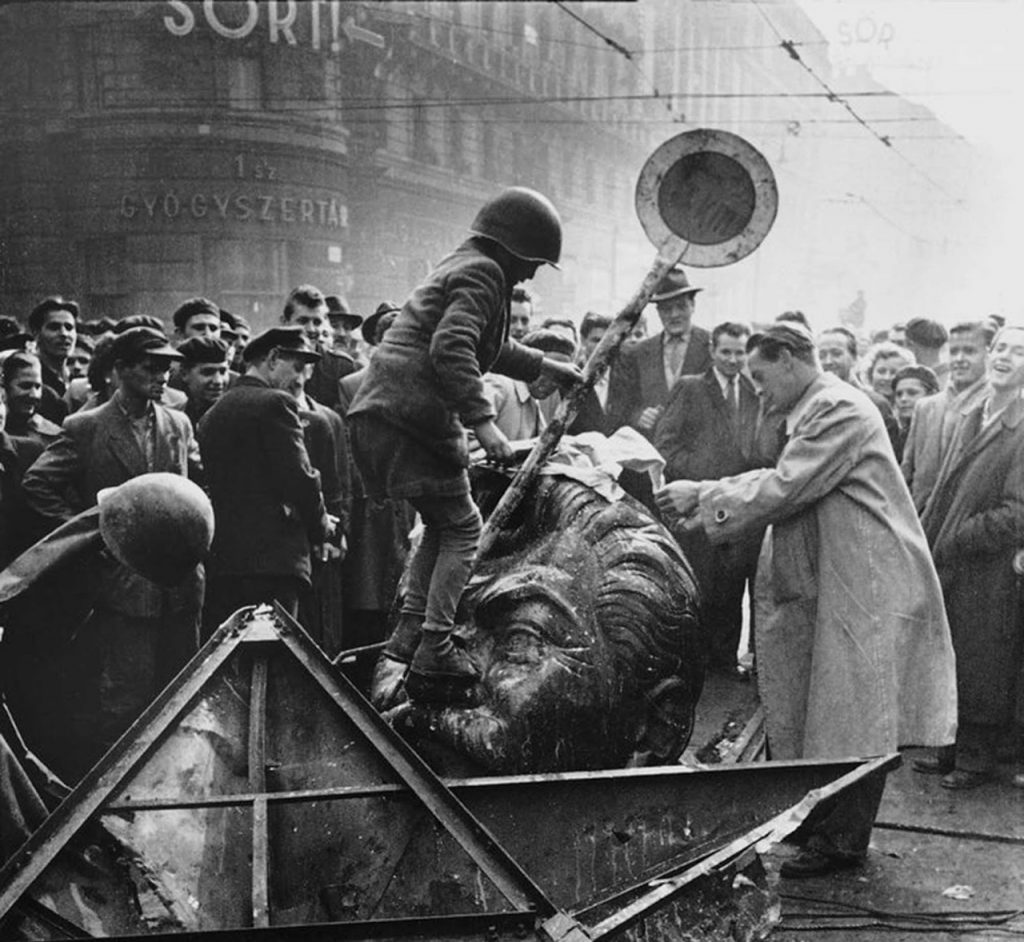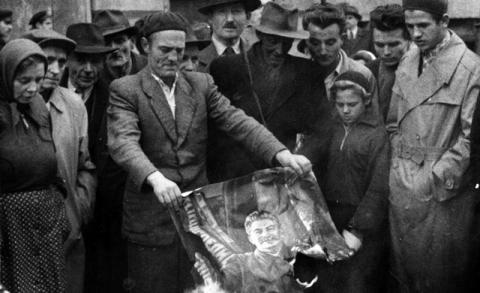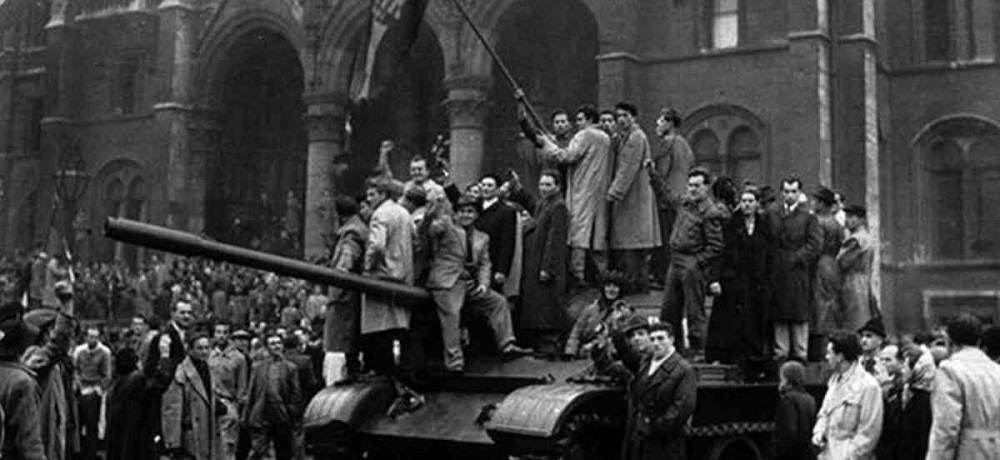Por Anabella Dalinger
Hace 64 años se desarrolló en Hungría una revolución contra el régimen burocrático estalinista, finalmente aplastada por tropas de la ex Unión Soviética. El estallido inició en Budapest, la noche del 23 de octubre, como una protesta estudiantil que exigía la independencia de la URSS, el retiro de las tropas del Ejército Rojo y la solidaridad con las manifestaciones del pueblo polaco, y se extendió nacionalmente con especial rapidez luego de que la movilización fuera brutalmente reprimida y muchos de sus activistas encarcelados.
Ese mismo día el secretario del Partido Comunista Húngaro, Erno Gerö, solicitó la intervención militar soviética para «sofocar una manifestación que estaba alcanzando una escala sin precedentes» y para las 2 de la madrugada del 24 de octubre, los tanques soviéticos ya estaban Budapest. El amplio repudio a la ocupación, el hambre creciente y el odio del pueblo por la cantidad de ejecuciones se transformaron en barricadas. Las tropas, tanto en Budapest como en las provincias, estaban divididas. Algunas, listas para luchar con el pueblo; otras, neutrales, dispuestas a entregar sus armas a los obreros para que estos pudieran combatir a la policía secreta.

Imre Nagy, quien había sido expulsado de su cargo y del Partido Comunista en 1953 por traidor, volvió al poder como medida de contención de la movilización luego del retiro de János Kádár al frente de un gabinete de coalición, prometiendo que el Ejército Rojo, que se había retirado de Budapest, pero continuaba en el país, abandonaría definitivamente Hungría.
El 1 de noviembre Nagy anunció la salida del Pacto de Varsovia, solicitando a las Naciones Unidas que reconocieran a Hungría como un país neutral bajo el amparo de las grandes potencias. El 4 de noviembre el Kremlin decidió que era momento de aplastar al pueblo húngaro y movilizó al ejército soviético con 31.550 soldados y 1.130 tanques a Budapest y otras regiones del país.
La resistencia del heroico pueblo húngaro continuó hasta el 10 de noviembre cuando finalmente un nuevo gobierno «obrero-campesino» dirigido por Janos Kadar y apoyado por los ocupantes soviéticos afirmó que la «contrarrevolución», como le llamaban a un pueblo que quería conquistar su propio gobierno, había sido derrotada y el orden restaurado.
La decisión de los líderes soviéticos de intervenir por segunda vez trajo desesperanza, quiebre virtual de la economía y un odio ardiente contra Rusia y todo lo ruso en los corazones de la población. Se estima que murieron más de 20.000 húngaros y 3.500 rusos; hubo decenas de millares heridos y devastación de grandes zonas de Budapest, además cientos de miles que huyeron en calidad de refugiados luego del retorno de la ocupación. (1)
Una etapa revolucionaria
Aquel proceso de ascenso que recorría el mundo en la posguerra, con grandes expresiones como la Revolución china y la lucha por la independencia de Argelia, Marruecos y Túnez, se reflejó también en la zona soviética. Les trabajadores a la ofensiva, provocaron discusiones en la izquierda mundial sobre el carácter de aquellos levantamientos.

Por un lado, quienes decían que era un pequeño grupo de fascistas, parte de la contrarrevolución mundial y por otro quienes opinaban que también las masas del oriente de Europa estaban a la ofensiva y querían conquistar su propio gobierno. Para ampliar su esfera de influencia en el mundo, la burocracia estalinista pactó con el imperialismo -que para ese momento estaba aterrorizado con los levantamientos- y entregó la revolución, transformándose en el principal sostén del debilitado régimen capitalista en Europa. (2)
Las miserias de la ocupación y el régimen totalitario
Hungría, luego de la ocupación, fue obligada a entregar a la Unión Soviética reparaciones por el valor de 600 millones de dólares y a pagar todos los gastos del Ejército Rojo estacionado y en tránsito por el país. Tan sólo en el primer año se expropiaron 4 millones de toneladas de cereal para alimentar a las tropas. Como en otros países de Europa oriental, los rusos constituyeron en Hungría sociedades mixtas.
Por supuesto, les trabajadores vivieron las miserias de cualquier ocupación: brutales normas de producción, salarios miserables, imposición del idioma, confiscación de las cosechas a los campesinos y una política prepotente para que entren en las colectividades agrícolas. Esta explotación de nación a nación que sufrieron los pueblos dominados por la Unión Soviética se reflejó en un régimen totalitario, que nada tenía que ver con el socialismo, sin democracia y con la imposición de una burocracia inventada en Moscú.
La prohibición de cualquier tipo de discrepancia en el terreno artístico, científico y político durante treinta años, donde todo se resolvía por absoluta unanimidad, escondía una sangrienta persecución política y llenaba las cárceles de genuinos militantes que osaban cuestionar. La política anti leninista de la burocracia, consistente en privilegios para algunos y explotación para les trabajadores, sólo podía sostenerse desde el terror porque poner a disposición los resortes del Estado para que el pueblo pudiera expresar sus opiniones libremente – premisa de la democracia bolchevique – hacía tambalear su poder.
Ese régimen totalitario se profundizó cada vez más, y si bien hasta ese momento no había liquidado las grandes conquistas económicas de la Revolución de Octubre como la nacionalización de la tierra, las industrias y el comercio exterior, o la planificación total de la economía, terminó con el contenido leninista de tales conquistas: la libre y democrática intervención de les trabajadores.
Una revolución nacional-obrera
Las huelgas insurreccionales en Berlín del este en 1953 fueron un importante precedente y su derrota por parte de la burocracia soviética, significaron una relativa calma. La nueva etapa, iniciada con la Revolución húngara en conjunto con la Revolución polaca serían una verdadera tormenta para el estalinismo. El movimiento de masas, toma aliento, se organiza para saltar a una nueva etapa caracterizada por grandes movimientos nacionales contra la opresión, explotación y el totalitarismo.
Esta enorme revolución, tuvo un doble carácter: Por un lado, nacional, donde toda la población intervenía contra el opresor extranjero. Y por otro, obrera, cuando avanza el movimiento en la lucha no solo contra la explotación rusa sino también contra la burocracia del propio país, quedando como única dirección la clase obrera.

Se desarrollaron tendencias que esperaban que la revolución contra la burocracia fuera por la vía pacifista y reformista. Por el contrario, nuestra corriente anunciaba que la presión del movimiento de masas era tan fuerte que se hacía inminente el enfrentamiento total y que esa casta burocrática no dejaría de ser contrarrevolucionaria porque no existían posibilidades para su transformación.
Las concesiones de la burocracia estalinista y la calma antes de la tormenta
A partir del XX Congreso del Partido Comunista de la Unión Soviética, luego de la muerte de Stalin, la burocracia rusa trata de contener por la vía de concesiones miserables la lucha de los pueblos oprimidos por Rusia, las promesas de mayores libertades solo tienen el objetivo de una mejor ubicación para pactar con el imperialismo.
La burocracia estalinista, con su característica de subestimar al movimiento de masas, no toma en cuenta que todo intento de aflojar es aprovechado para un nuevo impulso y marcha hacia adelante. Así, la Revolución húngara es la explosión generalizada contra la opresión nacional, la explotación social y el totalitarismo político.
El proceso revolucionario puso de manifiesto los puntos en común entre la burocracia rusa y el imperialismo que en conjunto acordaron contra el movimiento de masas. La Iglesia llamó a la «paz social» aunque el montaje quería instalar alrededor del mundo que había sido quien había iniciado las revueltas, para deslegitimarlas ya que era repudiada por la izquierda a nivel mundial.
El problema de la dirección
En el desarrollo de la lucha contra la ocupación soviética, la explotación y el totalitarismo, fueron surgiendo claras manifestaciones de doble poder, característica general de todo país sacudido por un intenso proceso revolucionario. La mayor parte de los integrantes de los comités eran antiguos miembros del Partido Socialdemócrata que, por una u otra razón, habían abandonado la actividad política desde que el Partido Comunista y el Partido Socialdemócrata se habían fusionado en el Partido de los Trabajadores Húngaros en junio de 1948.
Peter Fryer, corresponsal en Hungría del diario comunista Daily Worker durante el proceso los describe como: “órganos de la insurrección -reuniendo a los delegados electos en fábricas, universidades, minas y unidades del ejército- y órganos de autogobierno popular que gozaban de la confianza del pueblo armado. Como tales tenían tremenda autoridad, y no es exagerado afirmar que hasta el ataque soviético del 4 de noviembre el poder real del país estaba en sus manos.»
El Ejército soviético aplastó la revolución. La falta de un partido revolucionario fue un elemento fundamental por el cual no se pudo instalar el poder obrero en Hungría. Los partidos comunistas y sus organizaciones no pudieron ser transformados, sino que cualquier cambio debía hacerse a pesar de ellos, y cualquier incipiente organización podía tener militantes que hubieran pertenecido a sus filas, pero debía ser necesariamente una organización nueva que buscara otro cauce, es decir un nuevo agrupamiento.
El trotskismo por sus debilidades y falta de extensión debido a la persecución por parte del estalinismo durante décadas, llegó a la cita en esas condiciones de debilidad, mientras les trabajadores de Hungría proclamaban en su emisión de la Radio Rajk, el 1 de noviembre: “Los que en cualquier forma y en nombre de cualquier partido cooperan con la potencia colonial ocupante son traidores no solo a Hungría, sino al comunismo, y debemos cambiarlos. Camaradas, el sitio de todo comunista húngaro honesto está en las barricadas”.
Como en aquel suceso, hoy en día, el movimiento de masas y los trabajadores siguen peleando contra el resabio aún existente de la burocracia stalinista. El caso de la rebelión en Bielorrusia, como fenómeno actual, al igual que el episodio revolucionario de Hungría, sigue requiriendo de una dirección para que, como decía Trotsky, “…la energía de las masas no se disipe, como se disipa el vapor no contenido en una caldera”.
1 – PETER FRYER, La tragedia de Hungría.
2- NAHUEL MORENO, El marco histórico de la revolución húngara




